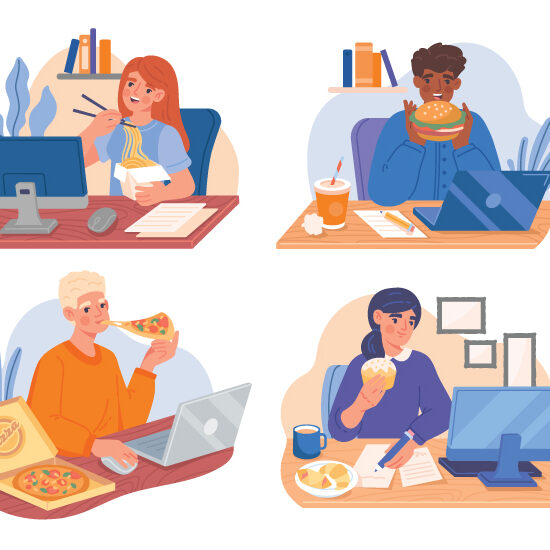What it Means to Work through Lunch
Employees who work through lunch may seem more productive, but the habit takes a toll on morale. Studies have found that eating lunch alone can lead to social isolation and weight gain.
Staying at your desk through lunch, even if you’re surfing the internet or taking care of personal business, is a missed opportunity for networking and bonding with coworkers and people in other departments.
For salaried employees, working through lunch is the same as giving your employer an extra hour of your time. Do this every day and those hours will add up.
Is Skipping Lunch the New Normal?
According to the “Take Back the Lunch Break” survey conducted by Tork, nearly 40 percent of workers said they rarely take a lunch break or any other breaks during the day. Nearly a quarter of those surveyed said they feel guilty if they stopped for a midday break. The same number worry that management will think they’re not working hard enough if they have lunch away from their desk.
With the increase in working from home during the pandemic, the boundaries between personal life and work have blurred for many people. We all know that taking a lunch break to rest and recharge is important for work-life balance. The Tork survey backs this up—nearly 90 percent of American workers believe lunch breaks help them refuel and recharge. Yet working through lunch is more prevalent than ever.
Lunch Break Benefits
Stepping away from work for a lunch break is more productive in the long run. Giving your brain a rest from work-related tasks can increase your focus and concentration when you return. Have you ever been stuck on a problem at work and then seen the solution as soon as you left? Getting away from work responsibilities and changing your surroundings helps your brain reset. A lunch break can give you a new perspective on your day.
Taking a true lunch break means getting away from your desk or workspace and sitting down to enjoy a meal, preferably with others. Teams and coworkers who socialize during lunch can get to know each other and strengthen working relationships. During the temporary break from workplace pressures, coworkers can share information and provide updates about their personal lives. For many, interacting at lunch will lead to stronger working relationships.
Too Busy for Lunch?
Most people who work through lunch would say their workloads demand it. They don’t believe they can leave work on time unless they skip breaks. Anyone in this situation needs to look for ways to schedule at least 30 minutes for a daily lunch break. This may mean working smarter, asking for help, or spending less time at unnecessary meetings. Whatever it takes, make it a priority!
Getting Back to Lunch Breaks
Tork is dedicated to helping people break the no-breaks habit with their national Take Back the Lunch Break campaign. According to Penny Tsavaris, Brand Communications Manager, “For years, we’ve called employees to take back the lunch break because we know they are happier and more productive when they step away from work midday.”
In the U.S., more work needs to be done to shift the workplace norm away from working through lunch. Employers need to recognize that time spent away from the office can increase productivity and promote work-life balance. Managers should actively encourage lunch breaks instead of assuming that employees will make time. Everyone needs to clear their calendar for lunch.
If you’re still not convinced that you need to make time for lunch, evaluate what you get done when you work through it. Does it really matter in the context of your entire day, or are you letting fear of what others may think to control your time?




